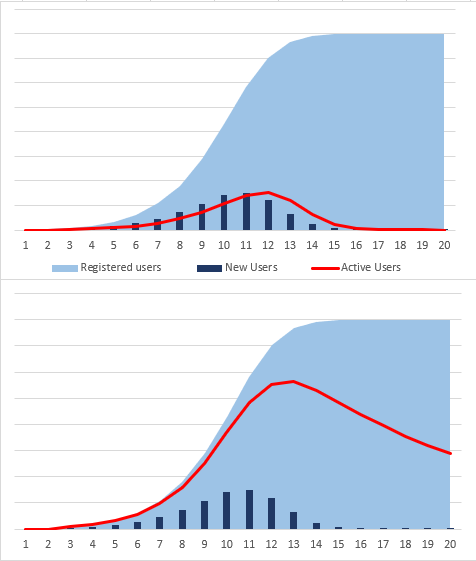- ARPDAUPosted 13 years ago
- What’s an impressive conversion rate? And other stats updatesPosted 13 years ago
- Your quick guide to metricsPosted 13 years ago
How Pocket Starships builds retention

Deputy Editor Zoya Street recently spoke with Lars Koschin of Spectacle Games, developer of Free-to-Play mobile MMO Pocket Starships, to understand how they design games to hit the elusive ‘midcore’ sweet spot.
Mid-core is a much-loved buzzword at the moment, but what does it take to design a game that appeals to the snacking practices of casual mobile players and the competitive instincts of hard-core players?
Pocket Starships builds complexity in layers by creating play cycles that alternative between a combat-oriented area that CEO Lars Koschin nicknamed the ‘Counterstrike zone’ and a farming-oriented ‘Hayday zone’. All players cycle between these two, but their pace and motivations lead them toward different resource management systems: Koschin calls these the ‘retention model’ or the ‘activity model’.
The ‘activity model’ is focused on personal combat prowess and the competitive urge to dominate. The premium currency economy is closely tied to the behaviours encouraged in the activity model: performing well in a battle earns a player the premium currency, which can then be spent on speeding up the crafting of items that can be used to be even more successful in future. Highly engaged players can spend money for even more premium currency.
The ‘retention model’ is focused on “the social link between players… People will remember you if you help them,” explained Koschin. “Activity people want you to join them because they need support.” Retention model players are drawn back in through the wait mechanics in the game’s farming and crafting areas, and the lockboxes won when playing support in a battle.
The retention player is not earning the same levels of premium currency as the activity player, but they are typically less interested in unlocking the ability to play the game for long stretches of time uninterrupted. “The traditional mobile player is not used to playing for ten hours.” For them, a game that allows them to step back and gives them a reason to return later is ideal. The premium currency earned through high performance in battles allows activity players to enjoy longer sessions more suited to their own preferred style of play.
Pocket Starships is designed to reward players every time they pick up the game by immediately allowing them to get a clear idea of what they’re going to do in this session. Fights are relatively short compared to PC MMOs: 15-20 minutes typically. A shorter play session will focus on harvesting crops and setting up new items to be crafted.
The larger narrative of Pocket Starships is also part of the retention game: an ongoing war between opposing factions. In an earlier build of the game, this war could in principle be won by one faction or the other, as long as they were successful in enough battles. Koschin confessed that they had to modify the game so that the war would never be won, in order to ensure that people could keep coming back to the game indefinitely. Nowadays, a losing side will find themselves supported by NPCs at just the right moment, maintaining a sense of hope for all players.













